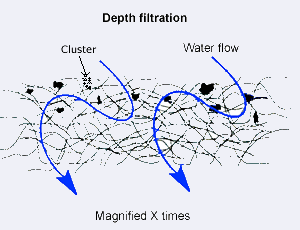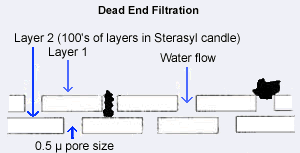World class ceramic water filters |
Doulton's Sterasyl Filtration Principle
Depth FiltrationParticle laden water are penetrating the porous filter medium. Depth filtration uses several mechanisms to separate the particles, e.g. sieving, impaction and interception. Particles are captured in the "depth" of the filter. Particles larger than 0.5 µm are generally removed by the sieving mechanism (see dead-end picture). Bellow 0.5 µm particles are removed by impaction and interception. Impaction occurs when a particle attempting to pass around an obstacle in its path, diverts by momentum from the flow stream and hits an other obstacle. Particles intercepted within the ceramic depth are much smaller than the pores measured by porometry. This is because particle laden water has to navigate through intricate maze of labyrinths. It turns, twists, dead ends and asperities* within the ceramic wall.
The result is particles intercepted from the stream are about one-third smaller than 0.5 µm pore size. The depth efficiency of the Sterasyl ceramic element is greater 98% at 0.2 µm. * All materials regardless how smooth and shiny may appear have "rough, thorns-like" surface called "asperities". |
For comparison of micron (µ) size human hair is about 70-100 microns thick. 0.5 micron particle can only be seen by a scanning electron microscope. Dead-end FiltrationWhen using a dead-end filtration technique, all the fluid passes through the membrane and all particles larger than 0.9 microns absolute pore sizes are stopped at its surface. Their size prevents them from entering and passing through the topmost layer of filter medium. This means that the trapped particles start to build up a "filter cake" on the surface of the ceramic media, which reduces the flow rate. Mechanical regeneration of the ceramic membrane is simple. The topmost blocked layer can be removed with stiff brush or scouring pad (e.g. Scotch Brite®). This can be repeated many times before the filter has to be changed.
|
User's Guide Countertop Systems Under Counter Doulton filters Whole House Water Filters/SALT FREE Softeners Portable Gravity Fed Systems Commercial Kitchens Equipment Industrial Water Purification Systems Filter Replacement Ceramic Candles and Cartridges Water Filter Faucets Boats/Motor Homes Fresh Water Treatment ALL PRODUCTS LIST




